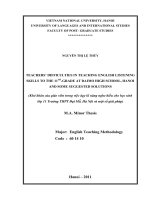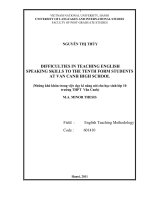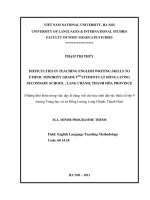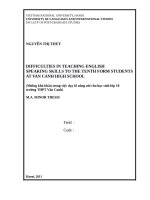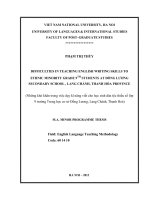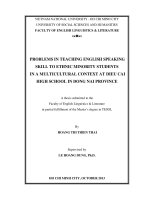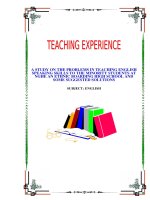Difficulties in teaching english writing skills to ethnic minority grade 9th students at đồng lương secondary school, lang chánh, thanh hóa province
Bạn đang xem bản rút gọn của tài liệu. Xem và tải ngay bản đầy đủ của tài liệu tại đây (496.39 KB, 50 trang )
VIET NAM NATIONAL UNIVERSITY, HA NOI
UNIVERSITY OF LANGUAGES & INTERNATIONAL STUDIES
FACULTY OF POST–GRADUATE STUDIES
*****************
PHẠM THỊ THÚY
DIFFICULTIES IN TEACHING ENGLISH WRITING SKILLS TO
ETHNIC MINORITY GRADE 9TH STUDENTS AT ĐỒNG LƯƠNG
SECONDARY SCHOOL , LANG CHÁNH, THANH HÓA PROVINCE
(Những khó khăn trong việc dạy kĩ năng viết cho học sinh dân tộc thiểu số lớp 9
trường Trung học cơ sở Đồng Lương, Lang Chánh, Thanh Hoá)
M.A. MINOR PROGRAMME THESIS
Field: English Language Teaching Methodology
Code: 60 14 10
HA NOI – 2013
VIET NAM NATIONAL UNIVERSITY, HA NOI
UNIVERSITY OF LANGUAGES & INTERNATIONAL STUDIES
FACULTY OF POST–GRADUATE STUDIES
*****************
PHẠM THỊ THÚY
DIFFICULTIES IN TEACHING ENGLISH WRITING SKILLS TO
ETHNIC MINORITY GRADE 9TH STUDENTS AT ĐỒNG LƯƠNG
SECONDARY SCHOOL , LANG CHÁNH, THANH HÓA PROVINCE
(Những khó khăn trong việc dạy kĩ năng viết cho học sinh dân tộc thiểu số lớp 9
trường Trung học cơ sở Đồng Lương, Lang Chánh, Thanh Hoá)
M.A. MINOR PROGRAMME THESIS
Field: English Language Teaching Methodology
Code: 60 14 10
Supervisor: Lê Văn Canh, PhD.
HA NOI – 2013
ABBREVIATIONS
1. CLT= Communicative Language Teaching
2. ESL= English as a Second Language
iv
LISTS OF CHARTS
1. Chart 1: Students’ preferences for learning writing skills
2. Chart 2: Students’ opinions on frequency of teachers’ feedback in each writing
lesson
3. Chart 3: Students’ opinions on difficulties of learning writing skills
4. Char 4: Students’ strategies to solve their difficulties in writing
5. Chart 5: Students’ opinion on forms of writing.
6. Chart 6: Students’ preferences for teachers’ methods in teaching writing
v
TABLE OF CONTENTS
DECRALATION……………………………………………………………….….i
ACKNOWLEDGEMENTS……………………………………………………….ii
ABSTRACT……………………………………………………………...……….iii
ABBREVIATIONS…………………………………………………………….....iv
LISTS OF CHARTS………………………..............................................…………v
TABLE OF CONTENTS…………………………………………………………vi
PART ONE – INTRODUCTION
1.1. Rationale of the study……………………………………………………...…..1
1.2. Aims of the study………………………………………………………………2
1.3. Research questions………………………………………………………….....2
1.4. Methods of the study………………………………………………..................2
1.5. Scope of the study………………………………….……………………….….3
1.6. Significance of the study……………………………………………………....3
1.7. Organization of the study………………………………………………….…..3
PART TWO - DEVELOPMENT
CHAPTER 1: LITERATURE REVIEW
1.1. Difficulties of Writing English as foreign languages……………………,,...…4
1.1.1. Content………………………………………………………………...……..5
1.1.2. Form……………………………………………………….……………..…..5
1.1.3. Spelling ………………………………………………………….…………..5
1.1.4. Punctuation …………………………………………………………….……7
1.1.4.1. Use commas when appropriate ……………………………………….…..8
1.1.4.2 Use a hyphen when using two words to act as one adjective (unless the first
word ends in -ly). …………………………………………..……………….……...9
1.1.5. Grammar ………………………………………………….…………………9
vi
1.1.5.1. Avoid using sexist wording, such as "he" or "his" when you are trying to
refer to both boys and girls or to both women and men. …………………………11
1.1.5.2. Do not combine singular and plural forms of words in the same sentence.
………………………………………………………………………………….…11
1.1.5.3. Do not write fragmented sentences. Every sentence needs a subject and a
predicate. ……………………………………………………………………….…11
1.1.5.4. Do not confuse "its" and "it's." "Its" is the possessive form of "it," whereas
"it's" is a contraction for "it is." ……………………………….……………….…12
1.1.5.5. Do not confuse "effect" and "affect." …………...…………………….…12
1.1.5.6. Use apostrophes in the appropriate place to indicate
possession…………………………………………………………..…………..…12
1.1.7.7. Do not use an apostrophe to indicate a plural form of a word. Only use it to
indicate possession. ………………………………….…………….……………..13
1.1.6. Usage …………………………………………………….………………..13
1.2. Causes of the difficulties………………………..……………………….…..14
1.2.1. Teachers’ teaching methods…………………….…………………….…...14
1.2.2. Difficulties related to the students’ variables………………………….…..16
1.3. Teaching Strategies to reduce the students' difficulties……………………...16
1.3.1. Encouragement to students……………………………………………..….16
1.3.2. Provide guidance throughout the writing process. ………………...………18
1.3.3.Remind students that writing is a process that helps them clarify ideas.
…………………………………………………………………………….……....19
1.3.4. Give students opportunities to talk about their writing.…………………....19
1.3.5. Use computers to help students write better. ………………………………19
1.3.6. During class pause for a three-minute write. ………………………...…….19
1.3.7. Have students write a brief summary at the end of class. …………………20
vii
1.3.8. Have one student keep minutes to be read at the next class meeting.
…………………………………………………………………………………….20
1.3.9. Use peer response groups…………………………………………..………20
CHAPTER TWO: THE STUDY
2.1. Overview of the textbooks……………………………..……………………..22
2.2. Context of the study…………………………………………………………..23
2.3. Methodology…………………………………………………...……………..24
2.4. The participants………………………………………………………………24
2.5. Data analysis of student’s survey questionnaire …………………………..…25
CHAPTER THREE: FINDINGS AND DISCUSSIONS……………………...31
PART THREE - CONCLUSION
3.1. Summary ……………………………………………………………………..34
3.2. Limitations of the study…………………………………………..…………..34
3.3. Suggestions of the study……………………………………………….……..35
REFERENCES…………………………………………………………….……..37
APPENDICES……………………………………………………………………..I
Appendix 1…………………………..…………………………………..………....I
Appendix 2………………………………………………………………………..III
Appendix 3………………………………………………………………………..IV
viii
PART ONE – INTRODUCTION
This chapter presents the rationale, the aims of the study, the research questions
and the methods used to achieve the aim. The scope and the significance of the
study are also presented. Finally, the chapter introduces the organization of the
study.
1.1. Rationale of the study
Today English is considered one of the most important factors to the trend
of globalization in all fields of life over the world. Thus, English as Second
Language has been taught in many countries and the demand to use English
fluently as well as to acquire four basic skills is becoming essential among all
students. As a result, methodology has been studied for years to find out the
most effective ways of teaching and learning English. In Vietnam, secondary
school students have to acquire four skills of English as reading, speaking,
listening and writing when they study English. Among them, writing is
considered the most difficult skill and at grade 9th students need to write
fluently. In order to do this, students should be provided with opportunities to
practice writing skill a lot.
In fact, each writing lesson is often boring because of some following
reasons. First of all, almost of the teachers and students do not like to teach and
learn this skill very much. It is quite difficult for the teacher to design an
interesting lesson and to make students easy to understand. Students find it
difficult to express their ideas, emotion, attitudes and not confident in using
grammar structures and vocabulary. Another reason is that writing lessons do
not have interesting activities to learn like other skills. Most lessons only require
students to sit down and write. This does not attract to students and makes them
bored.
Although the researcher of this study were aware of the difficulties the
students of Muong ethnics encountered frequently in their writing through
1
marking their writings, the data had never been collected and analyzed
systematically. This fact encouraged the researcher to carry out this study in the
hope that data-based sources of the students can be identified. This information
is believed to help the researcher find more practically effective ways to reduce
these students’ writing difficulties.
1.2. Aims of the study.
This research is designed to explore the difficulties in teaching writing
skills to ethnic minority 9th students. These difficulties are explored indirectly
through students’ self-reported difficulties they encountered in learning to write
English. It is expected to achieve the following aims:
(i) to investigate the difficulties in teaching writing English via the
students’ self-reported difficulties they are faced with;
(ii) to gain understanding of why the students have those difficulties in
writing English;
(iii) to find ways to help students reduce the difficulties they have in
learning to write English in the context of a secondary school in a mountainous
area.
1.3. Research questions
In order to achieve the mentioned aims above, the following research
questions are raised for this study:
1. What difficulties do ethnic minority grade 9 students encounter in
writing English?
2. Why do they have those difficulties?
1.4. Methods of the study
This is a survey study, and the major method used for the study is
quantitative. Data were collected by the questionnaire which was developed and
administered to the students by the researcher herself. In addition, the
information from friendly chats with the teachers was also used. Data were then
analyzed quantitatively in terms of the percentage.
2
Questionnaires for students will help the researcher understand why they do
not want to learn this skill and why the teacher often ignores it. From that, the
researcher will give some suggestions to improve both teachers’ methods in
teaching and in learning. Moreover, she also provides some ways to increase the
students’ preference in learning it.
1.5. Scope of the study
This study focuses on the investigation of the difficulties of the ethnic
minority grade 9 students in one school located in a mountainous area of Thanh
Hoa province only. There is no intention to generalize the results. In other
words, what is true to the group of students participating in this study may not
be true to other groups of students.
1.6. Significance of the study
The research is carried out with the hope that the results of the study will
provide significant insights into difficulties both teachers and students in
teaching and learning this skill. This may lead to suggestions for improving
teachers’ difficulties and helping the students more successfully in their writing
revision.
1.7. Organization of the study
This study has three main parts: introduction, development, and conclusion.
The introduction briefly states the rationale of the study, the aims, research
questions, scope, methods, the significance and the design of the study. The
development consists of three chapters: Chapter 1 provides a review of literature
on writing in general. Chapter 2 contains the core part of the study including the
context of the study, the methodology, the collection and analysis of the data for
the research, the findings and implications. Chapter 3 mentions the findings and
discussions for improving difficulties in teaching and in learning. The
conclusion at the end gives a summary of the main issues that have been
discussed so far in the study and suggestions for further research.
3
PART TWO - DEVELOPMENT
CHAPTER 1: LITERATURE REVIEW
This chapter focuses on some of the most important issues in the theories of
difficulties in teaching writing skills in general and in Dong Luong secondary
school in particular.
1.1. Difficulties of Writing English as foreign languages
Writing is “frequently accepted as being the last language skill to be
acquired” (Nunan 1991: 91) and it is true in Dong Luong secondary School, as
in other EFL contexts, that mastering written skills is a major challenge for
students. In order to identify ways in which students in this school might be
supported in the development of their writing, this thesis presents the writing
difficulties those secondary school learners of English face. Each student should
know that effective writing “…requires a number of things: a high degree of
organization in the development of ideas and information; a high degree of
accuracy so that there is no ambiguity of meaning; the use of complex
grammatical devices for focus and emphasis; and a careful choice of
vocabulary, grammatical patterns, and sentence structures” (Hedge 1988: 5).
Additionally, effective writing is also focused on the topic and does not contain
extraneous or loosely related information. To gain the good level in writing
English, students should know the difficulties in learning this skill.
1.1.1. Content
ESL students may lack the ability to express clear main ideas. The way
students form phrases often influences the audiences' understanding of the
written content. English compositions usually require conciseness and clear
main ideas, while Eastern languages, for example, use circular thinking and
digressions, according to the Dartmouth Writing Program. Writing in English
might be difficult for ESL students because they are not used to stating their
4
point clearly, so their audience may not be able to follow their intricate writing
style and understand the main ideas of the text.
Vietnamese students apply the way of writing Vietnamese literature to
writing English. According to Vietnamese writing styles student do not present
directly ideas that they want to express. They often use other ways to start their
written works instead of writing directly. This makes them more difficult in
learning English although they have learnt it for a long time. When learn how to
write in English they are not easy to follow new methods. As the result they are
bored and give up learning early. Teachers in school waste a lot of time to
rebuild their motivation and patients with the hope that students will like to learn
English writing.
1.1.2. Form
English writers usually compose distinctive paragraphs of four or five
sentences each; the first sentence is the main idea of the paragraph, and the other
sentences support it with examples or further explanations. In other cultures,
especially in non-English speaking European countries, the main idea is at the
end of the paragraph and stands as the conclusion the whole paragraph comes to,
the Dartmouth Writing Program notes. Moreover, ESL students need to know
the elements of the different English composition forms and the writing
conventions that go with them. For example, a letter to a friend is informal and
simple while a letter of complaint needs specific details, like an address and
phone number at the top of the letter as well as certain salutation formulas.
1.1.3. Spelling
English spelling is irregular and even many native-speaker adults have
difficulties with it. Spelling mistakes do not usually prevent the reader from
understanding what the writer is trying to say, but they can create a negative
impression. For this reason it is advisable to try to remove them from important
5
pieces of writing. Probably, the best way is to write on the computer and use a
spell-check. Diligent use of a dictionary is a good alternative. For high stakes
writing, e.g. job applications, the piece should be given to a teacher to check
over. Extensive reading in English is a very good way in the longer term to learn
English spelling patterns, so that mistakes are less likely.
Here’s a quick-reference guide to the top misspellings according to the
Oxford English Corpus – an electronic collection of over 2 billion words of real
English that helps us to see how students are using the language and also shows
us the mistakes that are most often made. The table gives the correct spelling of
the word, handy tips on getting it right, and also the most common misspellings
that we’ve found in our research, so you can check to see if any of the same
mistakes have been tripping you up.
Correct spelling
Spelling advice
Common misspelling
accommodate,
two cs, two ms
accomodate,
accommodation
accomodation
achieve
i before e
acheive
across
one c
accross
aggressive, aggression
two gs
agressive, agression
apparently
-ent not -ant
apparantly
appearance
ends with -ance
appearence
argument
no e after the u
arguement
assassination
two double s’s
assasination
basically
ends with -ally
basicly
beginning
double n before the – begining
ing
believe
i before e
beleive, belive
bizarre
one z, double -r
bizzare
6
business
begins with busi-
buisness
calendar
-ar not -er
calender
Caribbean
one r, two bs
Carribean
cemetery
ends with -ery
cemetary
chauffeur
ends with -eur
chauffer
colleague
-ea- in the middle
collegue
coming
one m
comming
committee
double m, double t,
commitee
double e
completely
ends with -ely
completly
conscious
-sc- in the middle
concious
curiosity
-os- in the middle
curiousity
definitely
-ite- not –ate-
definately
dilemma
-mm- not -mn-
dilemna
Disappear
one s, two ps
dissapear
Disappoint
one s, two ps
dissapoint
Ecstasy
ends with –sy
ecstacy
Embarrass
two rs, two s’s
embarass
environment
n before the m
enviroment
Existence
ends with -ence
existance
Fahrenheit
begins with Fahr-
Farenheit
Familiar
ends with -iar
familar
Finally
two ls
finaly
Fluorescent
begins with fluor-
florescent
1.1.4. Punctuation
ESL students need to learn certain aspects of the English punctuation
system, such as the way to punctuate direct speech. In general, however, the
7
most serious of punctuation mistakes are made not only by ESL students, but by
native speakers too. These mistakes are due to the lack of a clear understanding
of what a sentence is, and they result in fragments (incomplete sentences) or
run-ons ('sentences' that do not end when they should).
Punctuation mistakes can often be spotted if the student reads the writing
aloud. If a natural pause in the reading does not correspond with, say, a comma
or a full-stop in the written text, then it is likely that the punctuation is faulty.
Important writing should be given to a competent native-speaker to check.
Extensive reading, especially of non-fiction, both in English and the mother
tongue, will help students understand the concept of the sentence as the basis of
good writing. These are common difficulties in writing when learning English:
1.1.4.1. Use commas when appropriate. Sometimes a comma should be
omitted, whereas other times including a comma may help to improve your
writing.
Use a comma when separating main clauses:
Wrong: We are here on this planet once and we might as well get a feel for the
place.
Right: We are here on this planet once, and we might as well get a feel for the
place.
Set off parenthetical material within commas.
Wrong: Sometimes people gossip as Barbara Walters has observed because they
want to be interesting.
Right: Sometimes people gossip, as Barbara Walters has observed, because they
want to be interesting.
Avoid unnecessary commas.
Wrong: The facts were selected, and organized with care.
8
Right: The facts were selected and organized with care.
Wrong: The Air Force debunked UFO sightings, but, millions of Americans
didn't listen.
Right: The Air Force debunked UFO sightings, but millions of Americans didn't
listen.
1.1.4.2 Use a hyphen when using two words to act as one adjective (unless
the first word ends in -ly).
Wrong: The college student sample was smarter than the high school sample.
Right: The college-student sample was smarter than the high-school sample.
Wrong: A completely-new product was put on the market today.
Right: A completely new product was put on the market today.
1.1.5. Grammar
The use of articles is a frequent morphology problem for ESL students because,
even if students learn the rules of using "the," "a" or "an," they have difficulties
with situations when they should omit them according to the context.
Prepositions are also difficult to use correctly; structures like "on time" and "in
time" may seem similar or identical in meaning to a non-native speaker.
Choosing the right verb tense form is also a common problem for ESL students,
especially when the tense is not marked with a time adverb, as in "I have seen
this movie."Following are examples of authentic writing mistakes which
students often have when writing :
9
GRAMMAR: VERBS
- tense (tense shift) He had loose clothes so nobody can see his body.
He didn’t talked so clearly. When he lay down his neck
- form
breaked.
- agreement
Many people was afraid of him.
- combinations
But Dr Treves helped him having an easier life.
GRAMMAR: NOUNS AND PRONOUNS
- singular/plural
He had 2 operation to take out the lumps of skin.
-
His left hand was normal and right hand was size of
articles/determiners elephant’s trunk.
- agreement
He took off his glasses and put it on the table.
GRAMMAR: SENTENCE STRUCTURE
- word order
The guy that took care of him gave him in the hospital his
own room.
- reported speech
I want to know how did Joseph Merrick make such a beautiful
- sentence
model.
fragments
Because his right leg was like an elephant’s.August 5 in Lee
- run-on sentences
Street Joseph Merrick was born when he was born his body
was terrible.
Learners often do not choose the correct English verb tense for expressing
an idea or do not use it in its correct form. They may fail to use the articles
(a/the) correctly, or place words in the wrong order in a sentence. Some
grammar mistakes are easy for learners to correct themselves, particularly if they
read their writing aloud. Other grammar mistakes are not easy to find, however,
10
because the learner simply does not yet know the correct way to express an idea
in English. Looking in a grammar book will not often help in such
circumstances - the best thing to do is to ask a native speaker to check the
writing. In the long term most grammar mistakes will disappear by themselves,
particularly if the learner does extensive reading in English. Those are some
common mistakes that students often have when writing
1.1.5.1. Avoid using sexist wording, such as "he" or "his" when you are
trying to refer to both boys and girls or to both women and men.
Wrong: When the subject reported being finished, the experimenter asked him to
complete a second questionnaire.
Right: When the subject reported being finished, the experimenter administered
a second questionnaire.
1.1.5.2. Do not combine singular and plural forms of words in the same
sentence.
Wrong: Each subject rated their own mood on the questionnaire.
Right: Each subject rated his or her own mood on the questionnaire.
Right: All subjects rated their own moods on the questionnaire.
Wrong: A variety of issues were presented at the meeting.
Right: A variety of issues was presented at the meeting.
1.1.5.3. Do not write fragmented sentences. Every sentence needs a subject
and a predicate.
Wrong: And for days tried to change my mind. (no subject)
11
Right: For days he/she/it tried to change my mind.
1.1.5.4. Do not confuse "its" and "it's." "Its" is the possessive form of "it,"
whereas "it's" is a contraction for "it is."
Wrong: Its time for a change.
Right: It's time for a change.
Wrong: What is it's purpose?
Right: What is its purpose?
1.1.5.5. Do not confuse "effect" and "affect." "Effect" is typically a noun,
meaning some consequence or result. "Affect" is typically a verb, meaning
to bring about an effect. (But note that "affect" also can be a noun meaning
emotional expression, and "effect" can be used as a verb to mean to cause
something to come into being.)
Wrong: The experimental manipulation caused an interesting affect.
Right: The experimental manipulation caused an interesting effect.
Wrong: The intervention did not effect the behavior of the therapy group.
Right: The intervention did not affect the behavior of the therapy group.
1.1.5.6. Use apostrophes in the appropriate place to indicate possession. A
word ending in "s" has an apostrophe at the end of the word; otherwise,
place an apostrophe followed by "s" to indicate possession.
Wrong: The student's faculty advisor was very committed to their learning.
12
Right: The students' faculty advisor was very committed to their learning. (if
more than one student)
Right: The student's faculty advisor was very committed to her learning. (if only
one female student)
1.1.7.7. Do not use an apostrophe to indicate a plural form of a word. Only
use it to indicate possession.
Wrong: The student's all have busy schedules.
Right: The students all have busy schedules.
1.1.6. Usage
These are the final type of error often seen in ESL students' writing. A
usage mistake does not break a grammar "rule", but is a word or string of words
that a native speaker would never use to express the particular meaning that the
ESL student is trying to convey.
A usage mistake is a word or a string of words in a sentence that is
grammatically possible*, but not usual in standard English. Hence native
speakers rarely make usage mistakes, but ESL students very often do. Such
mistakes frequently occur in ESL students' work when they look up a word in
their own language and select the wrong English equivalent for the meaning
they wish to express. Conversely, failure to use the dictionary can result in the
false friends usage mistake. For example, kontollieren in German means to
check (over), so the following problem in the German student's writing is not
surprising: "It is important to control (i.e. check) the results carefully." Faulty
usage in larger passages of writing is often the consequence of the attempt to
render word-for-word into English the mental or written version that the ESL
student has in the native tongue. It is such mistakes in an ESL student's work
13
that can make it difficult to understand what meaning is being conveyed. Usage
mistakes, like grammar mistakes, are not particularly susceptible to eradication
by direct correction. And like grammar mistakes they will eventually disappear,
particularly if the student reads extensively in English. However, the mainstream
teacher is advised to alert an ESL student to usage mistakes in the way he or she
conveys a meaning that is common or integral to the subject. For example: "The
dictator was thrown over (overthrown) in a people's revolt or
Usage mistakes can often be more of a problem to the reader than
grammar mistakes. The ESL student who writes My mother don't speak English
or Then I putted beaker on tripod will be understood. On the other hand, the
student who writes in a journal My mother has an arrangement with her
operator today will not be understood to mean that his mother has an
appointment with her surgeon. It is usage problems rather than grammar
problems in extended pieces of writing that immediately identify even the most
proficient of ESL students as non-native speakers. Once again, the short-term
solution to usage problems is to ask a native speaker to check the work; and the
long term solution is to do lots of reading in English.
These are some difficulties in learning and teaching writing English skills.
Difficulties in content, forms, spelling and punctuation are the most common
that make students are confused and complicated.
1.2. Causes of the difficulties
There are a lot of reasons that make English writing skill difficult and
boring. In this thesis, I present about two main ones. They are teachers’ teaching
methods and difficulties related to the students’ variable
1.2.1. Teachers’ teaching methods
14
Problems are from the inadequate training and skills of the teachers. The
problem comes from the teachers themselves because they are also second
language learners of English and have faced similar conditions toward writing as
students do. As Vietnamese teachers, they often use their knowledge, culture
and life styles of Vietnamese people to impose on each English lesson. That why
students translate, speak as well as write word by word. As the result, students
learn in wrong ways and they are becoming bored and unexcited about English.
For teachers, there are not many interesting activities in designing English
writing lesson. They often make their lesson simpler and more boring by giving
students suggested words and asking them to match or completing sentences.
Sometimes teachers give students outlines or guidance. This makes students
lazier because they do not need to think much or use their brain. Teachers often
do that to make each lesson easier for students but this brings disadvantages.
They only sit down and write without thinking. That is reason why students’
English writing is never better.
In only 45 minutes for each period teachers can not explain and check all
students’ written works. Although there are common errors like “a” “an” and
“the”, teachers do not have enough time for all class. They only focus on some
good students’ writings if they have any questions. Other students can not be
checked and this becomes a learning habit in both teaching and learning. Even if
teachers give students too many new words and it is difficult to remember and
use correctly. Students can not learn by heart in the same time and reduce the
ability of learning English in general and in writing in particular. May be
teachers ask students to write many paragraphs instead of writing short ones.
Students feel too difficult and give up writing. With this method teachers do not
waste much time explaining fro students but the result of learning and teaching
is not high.
15
1.2.2. Difficulties related to the students’ variables
Writing is hard work for all of the students. The blank page threatens
them. The writer's main resource is himself, and lies in their fear that we can't
write because we haven't anything worth saying. Students sometimes feel that
they not only have nothing to say, but couldn't say it if they did. Students are
plagued by problems in spelling or grammar, difficulties in organizing their
thoughts on paper or explaining themselves clearly. Anger, defensiveness, and
embarrassment are typical reactions to these fears.
One reason for students' fear is that they feel uncertain about their use of
grammar and spelling. Their concerns for creating a "perfect" essay get in the
way of their ideas. Grammar and spelling are like the directions to baking a cake
or making a pizza--necessary, but hardly satisfying. The only way to learn how
to write is by writing. Too often, students focus on grammar and spelling early
because they view writing as a chore to finish as quickly as possible. The poet
William Stafford once wrote that "A writer is not so much someone who has
something to say as he is someone who has found a process that will bring about
new things he would not have thought of if he had not started to say them"
(Stafford 17). The real pleasure in writing doesn't come from knowing what to
say but from the joy of discovering what we don't know, didn't guess, until we
discovered it on the page before us. Once we know what we want to say, then
we can concentrate on how to say it--clearly, concisely, convincingly, and
correctly.
1.3. Teaching Strategies to reduce the students' difficulties
1.3.1. Encouragement to students
Writing skill offers a way of communicating one’s thought and
feelings on paper. So the message must be loud and clear between the
16
teacher and the students. First of all, encouragement to students is considered
as the best strategy to reduce students’ difficulties in writing English. According
to (Clifford, 1991, p.42), “The teacher has to encourage learners to write
for communication. They should focus on the ideas and meanings they wish to
convey rather than on mechanics of writing, such as spelling, and handwriting.”
The teachers play an important role in teaching writing and they are the
only ones who could help prevent problems of writing that could slow the
process
of learning
English,
specifically
writing.
It can be done by
encouraging students to write to communicate student to student, student to
teacher, or student to foreigner. I hope that this thesis will benefit many English
teachers to identify the problems that should be avoided while teaching. This
may give teachers the chance to help and lead the students to be better writers in
the future using the foreign language with the least possible obstacles and to
develop a deepened understanding of the delightful skill of writing.
According to (Shouman, 2002), “the teacher’s role is to persuade the
students to think how best to convey what he or she wants to say and to
feel responsible”. Encouragement gives students the feeling that they could be
trusted for what they put on papers. Also encouragement gives students the
confidence that they can learn to monitor and self-correct own errors to improve
their overall accuracy. “Teachers feel unsure of themselves when confronted
with
giving
suggestion
on students’ writing”
(Digest, 1996, p.3). This
supports the idea that “teachers who do not get enough practice for writing
approaches will not be able to give any advice to students to improve
the styles of writing”. Pinsent (1992, p.99) asks that we “Encourage students
to write and look at what they produce.” This will help students to talk about
what they have written since speaking precedes writing.
The role of the teacher is to encourage the students’ work and let
them keep on writing, no matter how the output is. “What the student needs is
17
to be able to write correctly so that he or she is not afraid to put words on paper
because of apprehension that the text may be couched in non-literary
language,” (Neville, 1988,
p.43). The teachers should backup students for
whatever is not afraid to put words on paper because of apprehension that the
text may be couched in non-literary language,” (Neville, 1988,
p.43). The
teachers should backup students for whatever is presented. But this does not
always work when students present unacceptable English. What teachers
can do is to politely not accept the work with some comments on the
weakness. They should not express 100% total dissatisfaction but, in an indirect
way, point to the problems to be prevented in the future so that no hard
feelings toward students expressed, making them depressed.
A knowledgeable teacher always finds ways to keep the students
eager to write by providing topics of interest and yet related to the school
curriculum. “Topics to be given to the students to write about are pre-selected
by the teacher and should have some relationship to their English
curriculum. Students will be able to write more, and more effectively, on
topics that relate to their linguistic and social background and are within
their semantic repertoire,” (Smadi, 1986, p.35). The topics that are brought
lives to students will always give results that have never been expected.
Teachers need to allow students to take a different role each time composing a
written form. “The role that is practiced by students will give them a
chance of creativity and countless more ideas for writing” (Runkle, 1988,
p.55).
1.3.2. Provide guidance throughout the writing process.
After teachers have made the assignment, discuss the value of outlines and
notes, explain how to select and narrow a topic, and critique the first draft,
define plagiarism as well.
18


